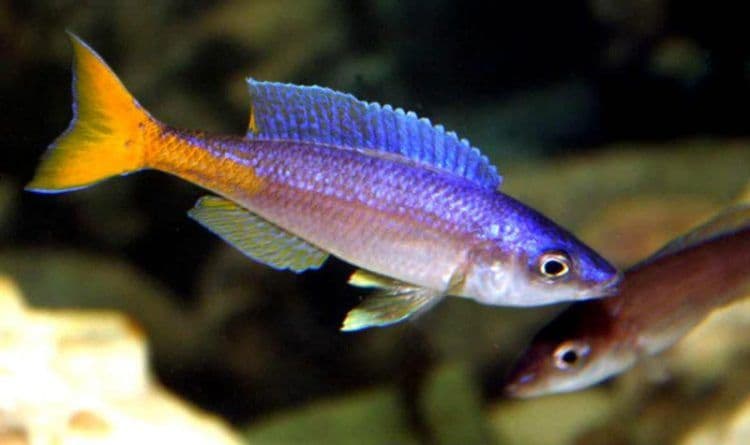
The genus Cyprichromis contains four species that were previously considered to be in the genus Limnochromis. The four species are C. nigripinnis, C. brieni, C. leptosoma and C. microlepidotus.Cyprichromis species are endemic to Lake Tanganyika, so they obviously like hard alkaline water. Most of the dissolved salts in Lake Tanganyika are derived from carbonates of calcium, magnesium and sodium. The dissolved salt level in Lake Tanganyika is double that of Lake Malawi and triple that of Lakes Victoria, Edward and Kivu. This should be kept in mind before attempting to keep and breed these species of fish.
Cyprichromis is a group of torpedo shaped schooling fishes. They are fairly peaceful and not territorial. A large tank of 36″ or more is necessary since they need a lot of swimming space. They will stay near the surface so the tank should be well covered. They often jump during courtship. If plants are provided they will spend a lot of time under broad leaves with their heads down and bodies at a 45 degree angle. These fish are open water spawners. After an egg has been laid, the female follows it as it sinks then picks it up. The eggs are fertilized in her mouth where she incubates them for about three weeks. When the fry are free swimming they are released and ignored by their mother.
The species I obtained last year at an auction in Detroit was C. leptosoma. They were fry about 1/2 to 3/4 of an inch in length. Now they vary from two to three inches. I have two males and four females. The females are a light brown with a little bit of silver on the sides of the head. Rather plain. The males are light silvery brown with a yellow tail. The dorsal fin is blue with black markings. The pelvic and anal fins are blue with yellow tips. My fish share the tank with a couple of Synodontis alberti and two Neolamprologus moori. The substrate is sand with a few rocks and a sponge filter.
They were fed a mixture of flake foods, floating pellets, frozen brine shrimp and frozen bloodworms. I didn’t see the spawning, but when I noticed the female was not eating, she was removed to another tank by herself. She hid behind the sponge filter for three weeks. I kept checking on her as her buccal cavity grew. Suddenly one day there were six fry 3/8 inches long swimming around the top of the tank. The female was removed and returned to the community tank with the others.
The fry were fed two to three times a day with powdered flakes, bloodworms, daphnia or frozen brine shrimp. Just like the adults, they all swim with their heads down. Small water changes are done weekly so as not to change the water chemistry too much. I have medium hard, alkaline well water, which seems to suit them. They might do better if I doctored the water some, but with the amount of tanks I run I try not to alter water chemistry.
Leave a Reply